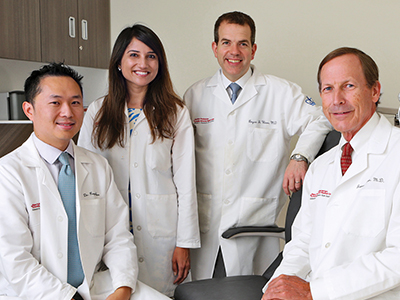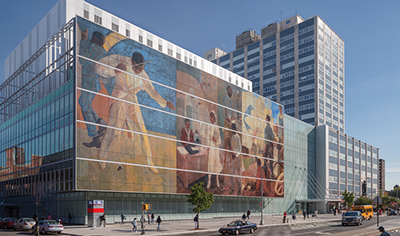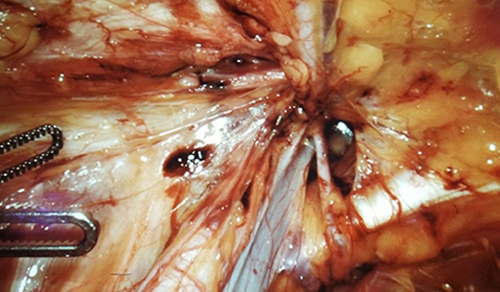Ophthalmology Residency Program: Transforming Eye Care in an Underserved Community

Dr. Royce W.S. Chen, Dr. Aakriti Garg, Dr. Bryan J. Winn, and Dr. James D. Auran
A new era of collaboration in vision science has emerged in upper Manhattan linking the ophthalmology departments of NewYork-Presbyterian/Columbia University Medical Center and Harlem Hospital Center (HHC).
For nearly two years discussions had been underway to develop a new teaching site for Columbia’s residency program and an expanded care platform for patients within the HHC system. This past year, the relationship was further strengthened with the appointment of Columbia ophthalmologist James D. Auran, MD, as the new Chief of Ophthalmology at Harlem Hospital Center.
The timing was ideal for forging a closer partnership between the two programs. Robert L. Farris, MD, HHC’s Chief of Ophthalmology, had planned to retire after four decades of service. “With the expansion of our residency program and the opportunity to bring our programs close together, we felt that Dr. Auran would be the perfect leader for the future,” says George A. Cioffi, MD, Ophthalmologist-in-Chief at NewYork-Presbyterian/Columbia.

In 2013, Harlem Hospital Center completed a major modernization of its facilities. The 286-bed institution, a member of NYC Health + Hospitals, is the only hospital in Harlem providing healthcare to its diverse community of cultures.
The two institutions agreed to establish a permanent rotation of Columbia ophthalmology residents at HHC and to bring on a new Chief of Ophthalmology who, in addition to overseeing administrative functions, would develop mechanisms for community outreach, faculty and staff recruitment, and expansion of the resident educational program. The relationship increases the number of Columbia residents from nine to 12, with one resident from each year on site at HHC at all times, and significantly broadens the Columbia resident experience with exposure to a different hospital system and a broad variety of patients and ocular disease.
HHC’s patient base frequently includes patients who need the most care, but have the least means to obtain it. Many patients have systemic health problems that complicate their ophthalmic conditions, while others have suffered severe ocular trauma. HHC is one of the few trauma centers throughout New York City, which expands the Columbia residents’ exposure to traumatic injuries.
“Our residents now have exposure to a Level 1 trauma center and an inner city public hospital experience that we believe is very valuable,” says Bryan J. Winn, MD, former Residency Program Director and Director of Medical Student Education, who helped to develop the new curriculum and broker the collaboration.
“The rotation at HHC gives our residents a greater clinical and surgical experience as well,” adds Dr. Winn. “It is a win-win for both institutions. HHC wanted to have expanded ophthalmology coverage and we wanted to provide our residents with exposure to a greater diversity of patients and disease. This is a population that is woefully underserved. Many are uninsured and have not had access to healthcare before. We see a lot of severe, end-stage disease. Through this collaboration, the patients at Harlem Hospital receive the same high level of cutting edge care that our patients at Columbia receive.”
“The expanded training curriculum made possible through our relationship with HHC is an important component of the residency program,” says Royce W.S. Chen, MD, the new ophthalmology Residency Program Director at Columbia. “It encompasses a diverse experience with patients from a variety of backgrounds, many who present with a level of ocular disease not typically seen, making the program attractive to residency candidates.”
A Mutually Beneficial Partnership
The opportunity to join Harlem Hospital Center in a senior administrative position very much appealed to Dr. Auran, who has high praise for the HHC Ophthalmology Department. “This is a wonderful staff of physicians. None of them has to be here. They’re here because they want to serve the underserved.”
Dr. Auran has begun adopting many of Columbia’s methodologies and protocols to help increase patient volume and flow at HHC, and he has introduced new treatment modalities to ensure that patients are receiving the highest quality care. “This has been an extraordinary turn of events for our residency program and for HHC,” says Dr. Auran.
Since his arrival, Dr. Auran also has been upgrading much of the Department’s equipment. “We recently added a laser optical biometer, a selective laser trabeculoplasty, and a Pentacam – a new corneal measurement system that will allow us for the first time in Harlem to make cataract surgery refractive surgery,” he says. “This is a major step forward for what we can offer this community.”
“HHC is a large city hospital, situated in an extremely vulnerable neighborhood. There is an incredible mix of ethnicities and socioeconomic classes and range of illnesses and disease.” — Dr. James D. Auran
Dr. Auran is equally impressed with the ophthalmology residents who have been accepted into the program. “The level of one extraordinary physician after another is amazing,” he says. “Two of our senior residents have won awards for best poster and presentation at the American Glaucoma Society and the American Society of Cataract and Refractive Surgery.”
Third-year resident Aakriti Garg, MD, earned her medical degree at Columbia University College of Physicians and Surgeons, where she had an interest in pursuing a number of specialties, but chose ophthalmology for several reasons. “I knew that I wanted to do surgery, but I also wanted to be able to follow my patients for a long time and really guide them through their illness,” says Dr. Garg. “I found that ophthalmology offered the best combination of surgery and medicine. Most of what we do is microsurgery, which requires a high level of precision. The surgeries that we do tend to have a great impact on peoples’ lives.”
Dr. Garg notes that many of her patients at HHC are seeing an ophthalmologist for the first time. “We start from the very beginning to understand the patient’s situation. We then put on our diagnostic hats, keep our minds open, and determine the diagnosis. Again, we’re often the first doctors that they see. We feel very lucky to be a part of their lives.”
Related Publications








